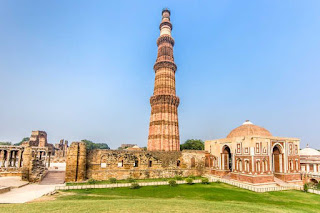1. Qutub Minar
2. Humayun Tomb
- Qutub Minar
Place in Delhi You must visit, Qutab Minar is 73 m-high tower of victory, made in 1193 by Qutab-ud-din Aibak. The tower has five distinct floras, each marked by a projecting balcony and tapers from a 15 m diameter at the base to just 2.5 m at the top. The first three floras are made of red sandstone; the fourth and fifth floras are of marble and sandstone. At the foot of the tower is the Quwwat-ul-Islam Mosque, the first mosque to be built in India. An inscription over its eastern gate provocatively informs that it was built with material obtained from demolishing ’27 Hindu temples’. A 7 m-high iron pillar stands in the courtyard of the mosque. It is said that if you can encircle it with your hands while standing with your back to it your wish will be fulfilled.

The origins of Qutab Minar are shrouded in controversy. Some believe it was erected as a tower of victory to signify the beginning of the Muslim rule in India.
It’s not only one in India, but also in the world. Qutab-ud-din Aibak, the first Muslim ruler of Delhi, commenced the construction of the Qutab Minar in 1200 AD, but could only finish the basement. His successor, Iltutmush, added three more floras, and in 1368, Firoz Shah Tughlak constructed the fifth and the last storey.
The development of architectural styles from Aibak to Tughlak is quite evident in the minar. The relief work and even the materials used for construction differ. The 238 feet Qutab Minar is 47 feet at the base and tapers to nine feet at the apex. The tower is ornamented by bands of inscriptions and by four projecting balconies supported by elaborately decorated brackets. Even though in ruins, the Quwwat Ui Islam (Light of Islam) Mosque in the Qutab complex is one of the most magnificent structures in the world. Qutab-ud-din Aibak started its construction in 1193 and the mosque was completed in 1197.
Iltutmush in 1230 and Alla-ud-din Khilji in 1315 made additions to the building. The main mosque comprises of an inner and outer courtyard,decorated with shafts and surrounded by piller. Most of these shafts are from the 27 Hindu temples, which were plundered to construct the mosque. It is, therefore, not surprising that the Muslim mosque has typical Hindu ornamentation. Close to the mosque is one of Delhi’s most curious antiques, the Iron Pillar.
2. Humayun Tomb
Delhi is the first of the grand dynastic mausoleums that were to become synonyms of Mughal architecture with the architectural style reaching its zenith 80 years later at the later Taj Mahal. Humayun’s Tomb stands within a complex of 27.04 ha. that includes other contemporary, 16th century Mughal garden-tombs such as Nila Gumbad, Isa Khan, Bu Halima, Afsarwala, Barber’s Tomb and the complex where the craftsmen employed for the Building of Humayun’s Tomb stayed, the Arab Serai.

Humayun’s Tomb was built in the 1560’s, with the patronage of Humayun’s son, the great Emperor Akbar. Persian and Indian craftsmen worked together to build the garden-tomb, far grander than any tomb built before in the Islamic world. Humayun’s garden-tomb is an example of the charbagh (a four quadrant garden with the four rivers of Quranic paradise represented), with pools joined by channels. The garden is entered from lofty gateways on the south and from the west with pavilions located in the centre of the eastern and northern walls. The mausoleum itself stands on a high, wide terraced platform with two bay deep vaulted cells on all four sides. It has an irregular octagon plan with four long sides and chamfered edges. It is surmounted by a 42.5 m high double dome clad with marble flanked by pillared kiosks (chhatris) and the domes of the central chhatris are adorned with glazed ceramic tiles. The middle of each side is deeply recessed by large arched vaults with a series of smaller ones set into the facade.




we are learning facebook pixel